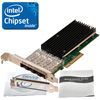Server Network Card Universal 10G/1G 4x SFP+ four SFP+ ports (Intel XL710 Based)
You can use any SFP+ transceivers (do not need to reprogram the SFP+ for Intel).
4x 4SFP+ 10G Universal Server Adapters with 10G SFP+ and 1G SFP (10GbE/1GbE) connectivity.
Key Features
Quad Port 10 GbE adapters
PCI Express* (PCIe) 3.0, x8
Exceptional Low Power Adapters
Network Virtualization offloads including Geneve, VXLAN, and NVGRE
Intel® Ethernet Flow Director for hardware-based application traffic steering
Intel® Data Plane Developer Kit (DPDK) optimized for efficient packet processing
Excellent small packet performa
Intel continues its legacy of Ethernet leadership by introducing a 40 gigabit family of adapters powered by, the Intel® Ethernet XL710 Controller, codenamed Fortville.
The XL710 adapter family addresses the demanding needs of the next-generation agile data center by providing unmatched features for both server and network virtualization, flexibility for L AN and SAN networks,and proven, reliable performance.
All Description PCI Express x8 4xSFP+ 10 Gigabit Server Adapter :
Product Overview
Intel continues its legacy of Ethernet leadership by introducing a 40 gigabit family of adapters powered by, the Intel® Ethernet
XL710 Controller, codenamed Fortville.
The XL710 adapter family addresses the demanding needs of the next-generation agile data center by providing unmatched
features for both server and network virtualization, flexibility for L AN and SAN networks,and proven, reliable performance.
Leading 10/40 GbE Performance
Optimized performance vectors (and key uses) include:
Small Packet Performance: Maintains wire-rate throughput on smaller payload sizes (>128 Bytes for 40 GbE and >64 Bytes
for 10 GbE
Bulk Transfer Performance: Delivers line-rate performance with low CPU usage for large application buffers
Virtualized Performance: Alleviates hypervisor I/O bottlenecks by providing flow separation for Virtual Machines (VMs)
Network Virtualization: Network virtualization overlay offloads including Geneve, VXLAN, and NVGRE
Storage Performance: Enables competitive performance with native OS drivers and intelligent offload for NAS (NFS, SMB),
and SAN (iSCSI and FCoE).
A Complete, Unified Networking Solution
Converging data and storage onto one fabric eliminates the need for multiple adapters, cables, and switches. Furthermore
both 10 and 40 gigabit Ethernet provides the bandwidth to converge these multiple fabrics onto a single wire. A key capability
that makes all this possible is traffic class separation provided by Data Center Bridging (DCB)1—providing a one-wire
solution with virtual pipes for the different classes of traffic:
Data: Best effort delivery of standard L AN traffic
Storage: Losslessnetwork for FCoE and iSCSI
Management: Guaranteed connectivity of data center
IP management
One Adapter, One Price
With the Intel adapters, iSCSI and FCoE support are included in the price of an adapter. There is no need to purchase
multiple adapters or additional licensing for an XL710 adapter. It’s simple and easy. Everything you need to unify your
networking is included in a single SKU. One adapter, one price.
Power Savings
Power efficiency is critical to IT specialists as energy consumption is a real OpEx concern.
Lowest Power Consumption: The new generation of XL710 adapters are power misers. They deliver double the
throughput with only half the power of the previous X520 generation.
Energy Efficient Ethernet (EEE): Reduces power consumption during periods of low data activity. Energy is used to
maintain the physical layer transmitters in a “ready state” to transmit data on the wire. During periods of low data traffic, EEE
sends a low-power-idle signal to putthe transmitters into a “low power state” saving power and cost. When data needs to be
sent, EEE sends a normal idle signal to wake up the transmit system before data is due to be sent so there is no degradation
of performance.
Server Virtualization
With Intel® Virtualization Technology (Intel® VT), the XL710 family of adapters deliver outstanding I/O performance
in virtualized server environments. They reduce I/O bottlenecks by providing intelligent offloads for networking traffic per
virtual machine (VM), enabling near-native performance and VM scalability. The host-based virtualization technologies
supported by Intel VT include:
VMDq for Emulated Path: Adapter-based VM Queue sorting enabling efficient hypervisor-based switching
Virtualized Performance: Alleviates hypervisor I/O bottlenecks by providingflow separation for Virtual Machines (VMs)
Network Virtualization: Network virtualizationoverlay offloads including Geneve,VXLAN,and NVGRE
Storage Performance: Enables competitive performance with native OS drivers and intelligent offload for NAS (NFS,
SMB), and SAN (iSCSI and FCoE)
SR-IOV for Direct Assignment: Adapter-based isolation and switching for various virtual station instances enabling optimal
CPU usage in virtualized environments
Additionally,XL710 adapters provide Virtual Bridging1 support that delivers both host-side and switch-side control and
management of virtualized I/O as well as the following modes of virtualized operation:
VEPA1:IEEE 802.1Qbgsupport for Virtual Ethernet Port Aggregator1
VEB: Virtual Ethernet Bridge support via Intel VT
Network Virtualization
Network virtualization is the next big trend in creating an agile data center. The family of XL710 adapters are ready to help you
take that next step.
VXLAN, NVGRE, Geneve Offloads: These stateless offloads preserve applicationperformance for overlay networks. With
these offloads it is possible to distribute network traffic across CPU cores.
At the same time XL710 offloads LSO, GSO, and checksum from the host software reducing CPU overhead.
Intel®Ethernet Flow Director
Flow Director is an advanced traffic steering capability built into the XL710 controller. It consists of a large number of flow
affinity filters that direct received packets by their flows to queues for classification, load balancing, and matching
between flows and CPU cores. It eliminates context switchingrequiredwithin the CPU. As a result, Flow
Director significantly increases the number of transactions per second and reduces latency for cloud applications
like Memcached.
Intelligent Offloads
The Intel® Xeon® processor family has demonstrated increased computing performance and increased integration of key
server subsystems generation after generation.
To offload is to leverage the ever-escalating computing power of the Intel Xeon processor where appropriate and implement
complementary accelerations in the network controller—this is what Intel refers to as “intelligent offloads.” By employing a
balanced hybrid of compute and offload, intelligent offloads are able to achieve the optimized point of performance
and efficiency. This is most notably observed in the following usage models:
TCP Stateless Offloads: Demonstrates leading performance vs. TOE solutions without restricting feature usage
(TOE usage usually requires that key features be disabled). Supported stateless offloads include Checksum, TSO, VMDq,
and RSS.
Host iSCSI/FCoE Initiators: Providing exceptional performance without the need for full-offload HBA methods.
Flow Classification: Trafficking data flows across multiple consumers and connections
Manageability
The XL710 family of adapters also incorporate the manageabilityrequiredby IT personnel for remote control and alerting.
Communication to the Board Management
Controller (BMC) is available either through an on-board SMBus port or the DMTF-defined NC-SI, providing a variety of
management protocols, including IPMI, BMC Pass-thru, OS2BMC, and MCTP/SMBus and MCTP/PCIe.
World-Class Intel Support
IntelCustomer Support Servicesoffers a broad selection oftechnical and customer support programs. For more information,
contact your local Intel representative. Service and availability may vary by country.
All features PCI Express x8 4xSFP+ 10 Gigabit Server Adapter :
General
Intel® XL710 10/40 Gigabit Ethernet Controller
QSFP+ Connectivity
Low-profile
Load balancing on multiple CPUs
iSCSI remote boot support
Fibre Channel over Ethernet (FCoE) Support
Support for most network operating systems (NOS)
RoHS-compliant
Intel® PROSet Utility for Windows* Device Manager
Time Sync (IEEE 1588, 802.1as)
I/O Features for Multi-core Processor Servers
Intel® Flow Director
MSI-X support
Multiple Queues: 1,536 Tx and Rx queues per port
Tx/Rx IP, SCTP, TCP, and UDP checksum offloading (IPv4, IPv6) capabilities
Virtualization Features
Next-Generation VMDq
PC-SIG SR-IOV Implementation (128 per device)
Virtual Machine Load Balancing (VLMB)
Advanced Packet Filtering
VLAN support with VLAN tag insertion, stripping and packet filtering for up to 4096 VLAN tags
VXLAN and NVGRE Support
Manageability Features
Preboot eXecution Environment (PXE) Support
Simple Network Management Protocol (SNMP) and Remote Network Monitoring (RMON) Statistic Counters
iSCSI Boot1
Watchdog Timer
Advanced Software Feature
Adapter fault tolerance (AFT)
Switch fault tolerance (SFT)
Adaptive load balancing (ALB)
Teaming support
IEEE 802.3ad (link aggregation control protocol)
PCIe Hot Plug*/Active Periphera component interconnect (PCI)
IEEE 802.1Q* VLANs
IEEE 802.3 2005* flow control support
Tx/Rx IP, TCP, & UDP checksum offloading (IPv4, IPv6) capabilities (Transmission control protocol(TCP), user datagram
protocol (UDP), Internet protocol (IP))
IEEE 802.1p*
TCP segmentation large send offload
MSI-X supports Multiple Independent Queues
Interrupt moderation
IPv6 offloading — Checksum and segmentation capability
TECHNICAL FEATURES:
Controller-processor: Intel® Ethernet Controller XL710
Network Standards: IEEE 802.3
Physical Layer Interface: 40GBASE-SR4
40GBASE-LR4
Operating temperature: 0 °C to 55 °C (32 °F to 131 °F)
Air Flow: Minimum of 150 LFM required
Storage temperature: -40 °C to 70 °C (-40 °F to 158 °F)
Storage humidity: Maximum: 90% non-condensing relative humidity at 35 °C
LED Indicators: LINK (solid) and ACTIVITY (blinking)
LINK SPEED (green=10 Gbps; yellow=1Gbps)
Data rate supported per port: Optical: 10GbE/40GbE
Direct Attach: 40 GbE
Bus type: PCI Express 3.0 (8 GT/s)
Bus width: 4-lane PCI Express* and 8-lane PCI Express
Interrupt levels: INTA, MSI, MSI-X
Network Operating Systems (NOS) Software Support
Windows Server 2012 R2*
Windows Server 2012 R2 Core
Windows Server 2012
Windows Server 2012 Core
Windows Server 2008 R2*
Windows Server 2008 R2 Core
Linux* Stable Kernel version 2.6.32/3x
Linux RHEL 6.5 and RHEL 7.0
Linux SLES 11 SP3 and SLES 12
FreeBSD* 9 and FreeBSD* 10
UEFI* 2.1
UEFI* 2.3
VMware ESXi 5.11 (Limited Functionality)
VMware ESXi 5.51





